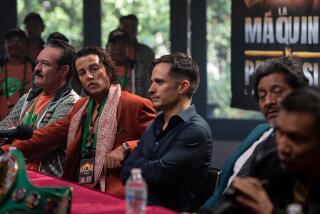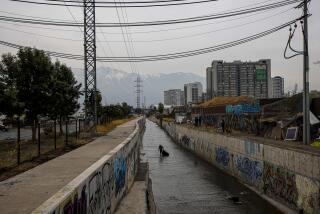CLANDESTINE IN CHILE:<i> The Adventures of Miguel Littin by Gabriel Garcia Marquez (Holt: $13.95; 114 pp.) </i>
Miguel Littin, a film maker exiled from Chile in 1973 and subsequently forbidden by the regime of Augusto Pinochet to return, did return in disguise for six weeks in 1985 to film a documentary about life under the present regime. “We particularly wanted to explore the living conditions of the people, their reaction to the dictatorship, and their methods of resistance,” he later told his friend, the novelist Gabriel Garcia Marquez, recounting the making of the film “Acta General de Chile.” Marquez tape recorded Littin’s account.
In his introduction to this small book, Garcia Marquez describes as condensation his manipulation of the 600-page transcript of his “grueling interrogation” of Littin. This is both modest and disingenuous. How does one condense a text? Not by compression but by deliberate excision and more than likely by extensive reorganization, for as anyone who has ever extracted a tale from a transcript knows, the narrative seldom falls out coherently, let alone compellingly.
Garcia Marquez selected the elements of a political thriller in Littin’s “adventure” to structure his telling. Strangers passing swiftly; shadows cast in alleys; encounters with authorities--”It was a woman supervisor I hadn’t noticed until then, a classic tough type, blonde and masculine, in a double-breasted uniform”; midnight roadblocks; elaborate passwords (“Are you going to the beach?” “No, to the zoo”); and flights from peril: All are copiously deployed. Less conspicuous, though unequivocal is his response to Littin’s insistent self-portrait of the film maker as a rebel, “thoroughly unconventional,” an irrepressible and spontaneous inventor of himself. Even when Littin does return to Chile, the pain of exile is not diminished because the price of his return is disguise, “the ignominy of having to live inside somebody else,” ironically a thoroughly conventional momio (“mummy”), a smug bourgeois, clean-shaven and smartly dressed, a type Littin despises ostentatiously. Home at last, he remains “exiled within myself.”
Garcia Marquez returns repeatedly to this theme of double exile: from country and from self. Time and again the obligatory twists of the thriller turn not on the demonstrable malevolence of Pinochet’s regime, but on Littin’s “irrational impulse to identify myself, to shout out my name . . . my right to be home.”
Indeed, it seems possible that Littin might have been able to make his film unmolested much in the way he contends that hundreds of exiles have returned and are clandestine in Chile pursuing resistance.
How worthy a guide is Littin after 12 years in exile? “Children who were 10 years old when I left . . . were now 22. . . . I had to question whether this harvesting of my nostalgia was worth the trouble.” How authentic the words he ascribes to the poor? “It’s not a roof over our heads or food that we’re worrying about. Let them give us back our dignity. . . . All we want is what they took from us: a say in our lives.”
More important, how realistic is his perception of himself? Early in his exile in Mexico he contrasted his approach to film with that of another Chilean political film maker, Helvio Soto: “There is the difference between one (like Soto) who looks down on the masses from a balcony and throws leaflets to them and one (like me) who finds himself in the midst of the masses and tries to participate, to transform himself, to become one of the people.”
Yet even before Littin was exiled from his native land, he was exiled within himself, which Garcia Marquez may know but certainly does not tell.
But for about 80 pictures produced in Chile from the end of the silents to the end of the ‘60s, film fare there was not “of the people,” but heavily colonized by comedies and melodramas from Mexico and Argentina and by Hollywood more and more.
Radically innovative Latin American films--the Brazilian cinema novo and Cuba’s output--were known to Littin and his contemporaries at first only by reputation through French film journals and later firsthand through the festival established at Vina del Mar. These films demonstrated a lesson forgotten since silent days: Films can be made cheaply without big equipment or stars.
Littin, a drama student, then television director in Santiago, made “El Chacal de Nahueltoro” in 1968, just as a popular cinema, emblematic of the Salvador Allende victory soon to come, arose. A semi-documentary about an illiterate murderer captured, condemned, imprisoned, taught a useful trade, then executed, it was distributed, not to the theaters of Santiago--where it might have become a succes d’estime at best--but to trade union halls, village schools, and open-air meetings, and finally, paradoxically, to festivals around the world.
From then on, despite his protestations, Littin was never really “thoroughly unconventional” or “of the people.” Like Brazil’s Glauber Rocha, he became a festival favorite and made “festival films.” His cinema was increasingly European: symbolic and rhetorical.
“The Promised Land” (1973), shot by Rocha’s cinematographer on “Antonio das Mortes,” was an ill-conceived pageant of popular uprising. “Actas de Marusia” (1976), made in exile, was purely a figment of festivals, a tedious entry in a then-crowded field of national liberation sagas, uniformly influenced less by history than by Italy, by Gillo Pontecorvo, Lucchino Visconti, and Sergio Leone. Like “Investigation of a Citizen Above Suspicion” and “The Working Class Goes to Heaven,” it starred Gian Maria Volonte, and like “Z” and “State of Siege,” it had a score by Mikis Theodorakis.
It was this exile from Chilean cinema as much as from Chile itself that Littin needed to resolve. Garcia Marquez, his book published before the film’s release, cannot tell us if he succeeded.
More to Read
Sign up for our Book Club newsletter
Get the latest news, events and more from the Los Angeles Times Book Club, and help us get L.A. reading and talking.
You may occasionally receive promotional content from the Los Angeles Times.






